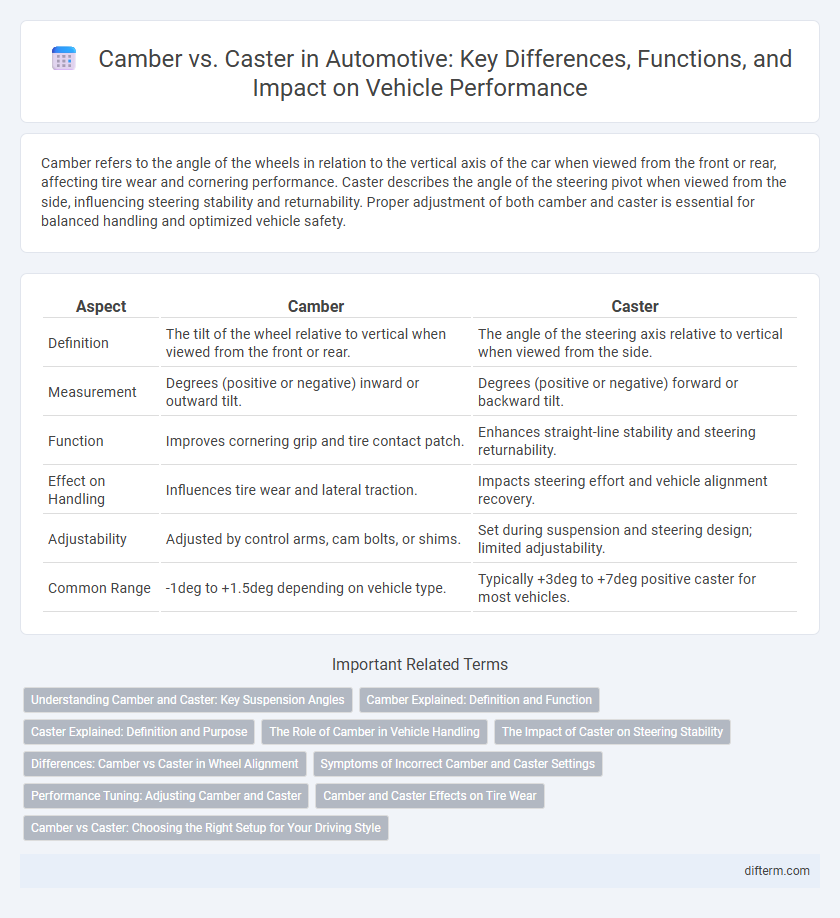Camber refers to the angle of the wheels in relation to the vertical axis of the car when viewed from the front or rear, affecting tire wear and cornering performance. Caster describes the angle of the steering pivot when viewed from the side, influencing steering stability and returnability. Proper adjustment of both camber and caster is essential for balanced handling and optimized vehicle safety.
Table of Comparison
| Aspect | Camber | Caster |
|---|---|---|
| Definition | The tilt of the wheel relative to vertical when viewed from the front or rear. | The angle of the steering axis relative to vertical when viewed from the side. |
| Measurement | Degrees (positive or negative) inward or outward tilt. | Degrees (positive or negative) forward or backward tilt. |
| Function | Improves cornering grip and tire contact patch. | Enhances straight-line stability and steering returnability. |
| Effect on Handling | Influences tire wear and lateral traction. | Impacts steering effort and vehicle alignment recovery. |
| Adjustability | Adjusted by control arms, cam bolts, or shims. | Set during suspension and steering design; limited adjustability. |
| Common Range | -1deg to +1.5deg depending on vehicle type. | Typically +3deg to +7deg positive caster for most vehicles. |
Understanding Camber and Caster: Key Suspension Angles
Camber refers to the tilt of the wheels inward or outward from the vertical axis, affecting tire contact and cornering performance. Caster is the forward or backward angle of the steering axis viewed from the side, influencing stability and steering feel. Proper adjustment of camber and caster angles optimizes handling, tire wear, and vehicle control in automotive suspension systems.
Camber Explained: Definition and Function
Camber refers to the angle of the wheels relative to the vertical axis when viewed from the front or rear of a vehicle, affecting tire contact with the road surface. Positive camber tilts the top of the wheel outward, enhancing stability at high speeds, while negative camber leans the wheel inward, improving cornering grip by increasing tire contact during turns. Proper camber adjustment optimizes tire wear, handling performance, and steering responsiveness in automotive suspension systems.
Caster Explained: Definition and Purpose
Caster refers to the angle of the steering axis when viewed from the side of a vehicle, measured in degrees. Its primary purpose is to enhance straight-line stability by helping the wheels return to a centered position after turning, improving handling and control. Proper caster settings contribute to smoother steering response and increased directional stability at high speeds.
The Role of Camber in Vehicle Handling
Camber angle directly influences tire contact with the road, optimizing grip during cornering for enhanced vehicle stability. Negative camber improves handling by increasing the tire's contact patch in turns, reducing understeer and promoting precise steering response. Proper camber adjustment minimizes uneven tire wear and boosts overall driving performance in both everyday and high-performance automotive applications.
The Impact of Caster on Steering Stability
Caster angle plays a critical role in enhancing steering stability by providing a self-aligning torque that helps the wheels return to the straight-ahead position after a turn. A positive caster angle increases directional control and improves high-speed stability by increasing the trail, which acts like a lever to maintain wheel orientation. Proper caster settings reduce steering effort and improve vehicle handling, especially during cornering and straight-line driving.
Differences: Camber vs Caster in Wheel Alignment
Camber refers to the inward or outward tilt of the wheel when viewed from the front, affecting tire wear and cornering performance. Caster is the angle of the steering axis viewed from the side, influencing steering stability and returnability. Understanding the differences between camber and caster is crucial for optimizing vehicle handling and tire longevity.
Symptoms of Incorrect Camber and Caster Settings
Incorrect camber settings cause uneven tire wear, such as excessive wear on the inner or outer edges, and can lead to poor handling or vehicle pulling to one side. Improper caster angles result in decreased steering stability, causing the vehicle to wander or requiring constant correction to maintain a straight line. Both camber and caster misalignments contribute to reduced tire life and compromised driving safety.
Performance Tuning: Adjusting Camber and Caster
Adjusting camber and caster angles plays a crucial role in automotive performance tuning by enhancing vehicle handling and tire contact with the road. Negative camber improves cornering stability by allowing the tire to maintain maximum grip during turns, while positive caster increases straight-line tracking and steering responsiveness. Precise tuning of these suspension settings enables drivers to achieve optimal balance between cornering performance and overall driving dynamics.
Camber and Caster Effects on Tire Wear
Camber influences tire wear by altering the contact patch; excessive negative camber causes inner edge wear, while positive camber leads to outer edge wear. Caster affects tire wear indirectly by improving steering stability and self-centering, which reduces uneven tire scrubbing during cornering. Proper alignment of camber and caster ensures balanced tire wear and optimal vehicle handling performance.
Camber vs Caster: Choosing the Right Setup for Your Driving Style
Camber, the angle of the wheels relative to the vertical axis, affects tire contact and cornering grip, while caster, the angle of the steering pivot, influences steering stability and self-centering. Negative camber enhances handling in sharp turns by maximizing tire contact but may increase inner tire wear, whereas positive caster improves straight-line stability and steering feel, crucial for high-speed driving. Selecting the right camber and caster balance depends on driving style: aggressive cornering favors more negative camber, while long-distance cruising benefits from increased caster angles for better control.
camber vs caster Infographic

 difterm.com
difterm.com